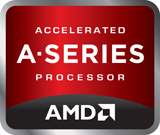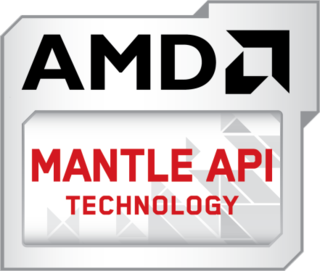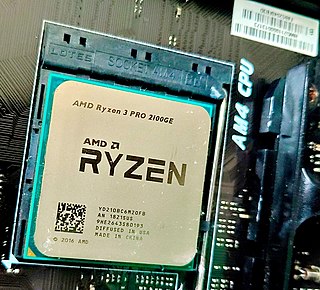
Advanced Micro Devices, Inc. (AMD) is an American multinational corporation and technology company headquartered in Santa Clara, California and maintains significant operations in Austin, Texas. AMD is a hardware and fabless company that designs and develops central processing units (CPUs), graphics processing units (GPUs), field-programmable gate arrays (FPGAs), system-on-chip (SoC), and high-performance compute solutions. AMD serves a wide range of business and consumer markets, including gaming, data centers, artificial intelligence (AI), and embedded systems.

A graphics processing unit (GPU) is a specialized electronic circuit initially designed for digital image processing and to accelerate computer graphics, being present either as a discrete video card or embedded on motherboards, mobile phones, personal computers, workstations, and game consoles. After their initial design, GPUs were found to be useful for non-graphic calculations involving embarrassingly parallel problems due to their parallel structure. Other non-graphical uses include the training of neural networks and cryptocurrency mining.

Radeon is a brand of computer products, including graphics processing units, random-access memory, RAM disk software, and solid-state drives, produced by Radeon Technologies Group, a division of AMD. The brand was launched in 2000 by ATI Technologies, which was acquired by AMD in 2006 for US$5.4 billion.

AnandTech was an online computer hardware magazine owned by Future plc. It was founded in April 1997 by then-14-year-old Anand Lal Shimpi, who served as CEO and editor-in-chief until August 30, 2014, with Ryan Smith replacing him as editor-in-chief. The web site was a source of hardware reviews for off-the-shelf components and exhaustive benchmarking, targeted towards computer-building enthusiasts, but later expanded to cover mobile devices such as smartphones and tablets.

AMD CrossFire is a brand name for the multi-GPU technology by Advanced Micro Devices, originally developed by ATI Technologies. The technology allows up to four GPUs to be used in a single computer to improve graphics performance.

Sandy Bridge is the codename for Intel's 32 nm microarchitecture used in the second generation of the Intel Core processors. The Sandy Bridge microarchitecture is the successor to Nehalem and Westmere microarchitecture. Intel demonstrated an A1 stepping Sandy Bridge processor in 2009 during Intel Developer Forum (IDF), and released first products based on the architecture in January 2011 under the Core brand.

AMD Accelerated Processing Unit (APU), formerly known as Fusion, is a series of 64-bit microprocessors from Advanced Micro Devices (AMD), combining a general-purpose AMD64 central processing unit (CPU) and 3D integrated graphics processing unit (IGPU) on a single die.
Unified Video Decoder is the name given to AMD's dedicated video decoding ASIC. There are multiple versions implementing a multitude of video codecs, such as H.264 and VC-1.
Graphics Core Next (GCN) is the codename for a series of microarchitectures and an instruction set architecture that were developed by AMD for its GPUs as the successor to its TeraScale microarchitecture. The first product featuring GCN was launched on January 9, 2012.

The Radeon 200 series is a series of graphics processors developed by AMD. These GPUs are manufactured on a 28 nm Gate-Last process through TSMC or Common Platform Alliance.

The GeForce 900 series is a family of graphics processing units developed by Nvidia, succeeding the GeForce 700 series and serving as the high-end introduction to the Maxwell microarchitecture, named after James Clerk Maxwell. They were produced with TSMC's 28 nm process.

Mantle was a low-overhead rendering API targeted at 3D video games. AMD originally developed Mantle in cooperation with DICE, starting in 2013. Mantle was designed as an alternative to Direct3D and OpenGL, primarily for use on personal computers. In 2015, Mantle's public development was suspended and in 2019 completely discontinued, as DirectX 12 and the Mantle-derived Vulkan rose in popularity.
High Bandwidth Memory (HBM) is a computer memory interface for 3D-stacked synchronous dynamic random-access memory (SDRAM) initially from Samsung, AMD and SK Hynix. It is used in conjunction with high-performance graphics accelerators, network devices, high-performance datacenter AI ASICs, as on-package cache in CPUs and on-package RAM in upcoming CPUs, and FPGAs and in some supercomputers. The first HBM memory chip was produced by SK Hynix in 2013, and the first devices to use HBM were the AMD Fiji GPUs in 2015.
The Radeon 400 series is a series of graphics processors developed by AMD. These cards were the first to feature the Polaris GPUs, using the new 14 nm FinFET manufacturing process, developed by Samsung Electronics and licensed to GlobalFoundries. The Polaris family initially included two new chips in the Graphics Core Next (GCN) family. Polaris implements the 4th generation of the Graphics Core Next instruction set, and shares commonalities with the previous GCN microarchitectures.

Kaby Lake is Intel's codename for its seventh generation Core microprocessor family announced on August 30, 2016. Like the preceding Skylake, Kaby Lake is produced using a 14 nanometer manufacturing process technology. Breaking with Intel's previous "tick–tock" manufacturing and design model, Kaby Lake represents the optimized step of the newer process–architecture–optimization model. Kaby Lake began shipping to manufacturers and OEMs in the second quarter of 2016, with its desktop chips officially launched in January 2017.

3D XPoint is a discontinued non-volatile memory (NVM) technology developed jointly by Intel and Micron Technology. It was announced in July 2015 and was available on the open market under the brand name Optane (Intel) from April 2017 to July 2022. Bit storage is based on a change of bulk resistance, in conjunction with a stackable cross-grid data access array, using a phenomenon known as Ovonic Threshold Switch (OTS). Initial prices are less than dynamic random-access memory (DRAM) but more than flash memory.

AMD Instinct is AMD's brand of data center GPUs. It replaced AMD's FirePro S brand in 2016. Compared to the Radeon brand of mainstream consumer/gamer products, the Instinct product line is intended to accelerate deep learning, artificial neural network, and high-performance computing/GPGPU applications.

Ryzen is a brand of multi-core x86-64 microprocessors, designed and marketed by AMD for desktop, mobile, server, and embedded platforms, based on the Zen microarchitecture. It consists of central processing units (CPUs) marketed for mainstream, enthusiast, server, and workstation segments, and accelerated processing units (APUs), marketed for mainstream and entry-level segments, and embedded systems applications.
Zen+ is the name for a computer processor microarchitecture by AMD. It is the successor to the first gen Zen microarchitecture, and was first released in April 2018, powering the second generation of Ryzen processors, known as Ryzen 2000 for mainstream desktop systems, Threadripper 2000 for high-end desktop setups and Ryzen 3000G for accelerated processing units (APUs).
PC Perspective is a web site dedicated to news and reviews of personal computing and gaming hardware. PC Perspective specializes in hardware that is most relevant to home users and enthusiasts. The site also has an active online community, a weekly podcast, and founder Ryan Shrout was the co-host of TWiT.tv's This Week in Computer Hardware.













